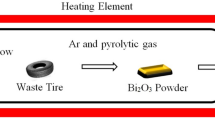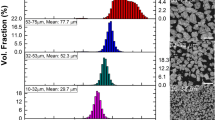Abstract
BPR has been widely used as ablative material for thermal protection on aircraft surface. In this study, model-free method was employed to study the kinetic models of BPR and ZrSi2/B4C-Ph composite. In addition, the thermal stability, chemical reaction and structure evolution during pyrolysis of ZrSi2/B4C-Ph composite were characterized by TGA, XRD, XPS, GC–MS and TG-MS. The results indicated that the pyrolysis of BPR includes three consecutive and overlapping stages. And the kinetic mechanism function f(α), apparent activation energy Ea and pre-exponential factor A of each stage were confirmed. Besides, the high char yield of ZrSi2/B4C-Ph composite is mainly attributed to the reaction of ZrSi2 and B4C with gases released during BPR pyrolysis, which formed solid phases such as amorphous carbon, ZrO2, SiO2 and B2O3.


















Similar content being viewed by others
References
Lin C-T, Lee H-T, Chen J-K. Preparation and properties of bisphenol-F based boron-phenolic resin/modified silicon nitride composites and their usage as binders for grinding wheels. Appl Surf Sci. 2015;330:1–9. https://doi.org/10.1016/j.apsusc.2014.12.193.
Wang F, Huang Z, Liu Y, Li Y. Novel cardanol-containing boron-modified phenolic resin composites. High Perform Polym. 2017;29(3):279–88. https://doi.org/10.1177/0954008316641196.
Mothé CG, Vieira CR, Mothé MG. Thermal and surface study of phenolic resin from cashew nut shell liquid cured by plasma treatment. J Therm Anal Calorim. 2013;114(2):821–6. https://doi.org/10.1007/s10973-013-2985-7.
Deng P, Shi Y, Liu Y, Liu Y, Wang Q. Solidifying process and flame retardancy of epoxy resin cured with boron-containing phenolic resin. Appl Surf Sci. 2018;427:894–904. https://doi.org/10.1016/j.apsusc.2017.07.278.
Wang C, Zhang B, Luo Z, Zhang Y, Zhou H, Guo Y, et al. Preparation and properties of a novel addition-curable phenolic resin containing boron element. Polym Adv Technol. 2018;29(12):3014–9. https://doi.org/10.1002/pat.4421.
Zou Z, Qin Y, Fu H, Zhu D, Li Z, Huang Z. ZrO2f-coated Cf hybrid fibrous reinforcements and properties of their reinforced ceramicizable phenolic resin matrix composites. J Eur Ceram Soc. 2021;41(3):1810–6. https://doi.org/10.1016/j.jeurceramsoc.2020.08.034.
La P, Genova V, Bracciale MP, Bartuli C, Marra F, Natali M, et al. Thermochemical characterization of polybenzimidazole with and without nano-ZrO2 for ablative materials application. J Therm Anal Calorim. 2020;142(5):2149–61. https://doi.org/10.1007/s10973-020-10343-4.
Mansouri J, Wood CA, Roberts Kd, Cheng YB, Burford RP. Investigation of the ceramifying process of modified silicone-silicate compositions. J Mater Sci. 2008;42(15):6046–55. https://doi.org/10.1007/s10853-006-1163-8.
Ghelich R, Mehdinavaz Aghdam R, Jahannama MR. Elevated temperature resistance of SiC-carbon/phenolic nanocomposites reinforced with zirconium diboride nanofibers. J Compos Mater. 2018;52(9):1239–51. https://doi.org/10.1177/0021998317723447.
Hu H, Zhang Y, Liu L, Yang Y, Yu R, Wang J. Effect of quantitative characteristic structure of resole phenolic prepolymer resin on thermal stability, pyrolysis behaviors, and ablation properties. J Therm Anal Calorim. 2020. https://doi.org/10.1007/s10973-020-10096-0.
Yang W, Xu B, Qi M, Chen D, Ding J, Huang Z, Wang Y. Improving ablation properties of ceramifiable vitreous silica fabric reinforced boron phenolic resin composites via an incorporation of MoSi2. Plast Rubber Compos. 2020;49(10):456–69.
Ding J, Yang T, Huang Z, Qin Y, Wang Y. Thermal stability and ablation resistance, and ablation mechanism of carbon–phenolic composites with different zirconium silicide particle loadings. Compos Part B-Eng. 2018;154:313–20. https://doi.org/10.1016/j.compositesb.2018.07.057.
He D, Shi M, Yang Y, Huang Z. Effect of inorganic components on properties of ceramizable phenolic resin matrix composites. IOP Conf Ser Mater Sci Eng. 2019;472(1):012044. https://doi.org/10.1088/1757-899x/472/1/012044.
Fu H, Qin Y, He X, Meng X, Zhong Y, Zou Z. Effect of curing degree on mechanical and thermal properties of 2.5D quartz fiber reinforced boron phenolic composites. E-Polymers. 2019;19(1):462–9. https://doi.org/10.1515/epoly-2019-0048.
Wang S, Wang Y, Bian C, Zhong Y, Jing X. The thermal stability and pyrolysis mechanism of boron-containing phenolic resins: The effect of phenyl borates on the char formation. Appl Surf Sci. 2015;331:519–29.
Li Y, Deng C, Shi X, Xu B, Chen H, Wang Y. Simultaneously improved flame retardance and ceramifiable properties of polymer-based composites via the formed crystalline phase at high temperature. ACS Appl Mater Inter. 2019;11(7):7459–71. https://doi.org/10.1021/acsami.8b21664.
Mirzapour MA, Haghighat HR, Eslami Z. Effect of zirconia on ablation mechanism of asbestos fiber/phenolic composites in oxyacetylene torch environment. Ceram Int. 2013;39(8):9263–72. https://doi.org/10.1016/j.ceramint.2013.05.034.
Ding J, Huang Z, Qin Y, Shi M, Huang C, Mao J. Improved ablation resistance of carbon–phenolic composites by introducing zirconium silicide particles. Compos Part B-Eng. 2015;82:100–7. https://doi.org/10.1016/j.compositesb.2015.08.023.
Wang Y, Chen L, Xu T, Yan Y, Gu J, Yun J, et al. High char yield novolac modified by Si-B-N-C precursor: Thermal stability and structural evolution. Polym Degrad Stabil. 2017;137:184–96. https://doi.org/10.1016/j.polymdegradstab.2017.01.013.
Asaro L, D’Amico D, Alvarez V, Rodriguez E, Manfredi L. Impact of different nanoparticles on the thermal degradation kinetics of phenolic resin nanocomposites. J Therm Anal Calorim. 2017;128(3):1463–78. https://doi.org/10.1007/s10973-017-6103-0.
Tuffi R, D’Abramo S, Cafiero LM, Trinca E, Ciprioti SV. Thermal behavior and pyrolytic degradation kinetics of polymeric mixtures from waste packaging plastics. Express Polym Lett. 2018;12(1):82–99. https://doi.org/10.3144/expresspolymlett.2018.7.
Ozawa T. A new method of analyzing thermogravimetric data. Bull Chem Soc Jpn. 1965;38(11):1881. https://doi.org/10.1246/bcsj.38.1881.
Senum GI, Yang RT. Rational approximations of the integral of the Arrhenius function. J Therm Anal Calorim. 1977;11(3):445–7. https://doi.org/10.1007/bf01903696.
Yi Z, Li C, Jiang J, Zhang J, Zhang W, Li J. Pyrolysis kinetics of tannin-phenol-formaldehyde resin by non-isothermal thermogravimetric analysis. J Therm Anal Calorim. 2015;121(2):867–76. https://doi.org/10.1007/s10973-015-4625-x.
Yao Z, Yu S, Su W, Wu W, Tang J, Qi W. Kinetic studies on the pyrolysis of plastic waste using a combination of model-fitting and model-free methods. Waste Manag Res. 2020;38(1):77–85. https://doi.org/10.1177/0734242x19897814.
Yousef S, Eimontas J, Striūgas N. Pyrolysis kinetic behavior and TG-FTIR-GC–MS analysis of metallised food packaging plastics. Fuel. 2020;282:118737. https://doi.org/10.1016/j.fuel.2020.118737.
Zhao Y, Yan N, Feng MW. Thermal degradation characteristics of phenol–formaldehyde resins derived from beetle infested pine barks. Thermochim Acta. 2013;555:46–52. https://doi.org/10.1016/j.tca.2012.12.002.
Fitzer E, Schäfer W. The effect of crosslinking on the formation of glasslike carbons from thermosetting resins. Carbon. 1970;8(3):353–64. https://doi.org/10.1016/0008-6223(70)90075-8.
Costaa L, Monteleraa LRd, Caminoa G, Weilb ED, Pearceb EM. Structure-charring relationship in phenol- formaldehyde type resins. Polym Degrad Stabil. 1997;56(1):23–35. https://doi.org/10.1016/s0141-3910(96)00171-1.
Duan L, Zhao X, Wang Y. Oxidation and ablation behaviors of carbon fiber/phenolic resin composites modified with borosilicate glass and polycarbosilane interface. J Alloys Compd. 2020. https://doi.org/10.1016/j.jallcom.2020.154277.
Narváez LOD, Martínez JR, Ruiz F. Preparation of (Ni–B)/SiO2, Ni/SiO2 and NiO/SiO2 nanocomposites. J Non-Cryst Solids. 2003;318(1–2):37. https://doi.org/10.1016/s0022-3093(02)01877-x.
Hao D, Song Y-X, Zhang Y, Fan H-T. Nanocomposites of reduced graphene oxide with pure monoclinic-ZrO2 and pure tetragonal-ZrO2 for selective adsorptive removal of oxytetracycline. Appl Surf Sci. 2021;543:148810. https://doi.org/10.1016/j.apsusc.2020.148810.
Yaowakulpattana P, Kondo S, Kadono K, Wakasugi T. Effect of B2O3 on crystallization behavior of ZnO-Al2O3-SiO2 glasses. J Ceram Soc Jpn. 2015;123(1434):96–9. https://doi.org/10.2109/jcersj2.123.96.
Sukkaew P, Ojamäe L, Kordina O, Janzén E, Danielsson Ö. Thermochemical properties of halides and halohydrides of silicon and carbon. ECS J Solid State Sc. 2016;5(2):27-P35. https://doi.org/10.1149/2.0081602jss.
McDonald RA, Curnutt JL, Downey JR, Syverud AN, Chase MW, Valenzuela EA. JANAF thermochemical tables 1982 Supplement. J Phys Chem Ref Data. 1982;11(3):695–940. https://doi.org/10.1063/1.555666.
Chase MW. NIST-JANAF thermochemical tables for oxygen fluorides. J Phys Chem Ref Data. 1996;25(2):551–603. https://doi.org/10.1063/1.555992.
Chen L, Goto T, Hirai T, Amano T. State of boron in chemical vapor-deposited sic-b composite powders. J Mater Sci Lett. 1990;9(9):997–9. https://doi.org/10.1007/bf00727857.
Burke AR, Brown CR, Bowling WC, Glaub JE, Kapsch D, Love CM, et al. Ignition mechanism of the titanium-boron pyrotechnic mixture. Surf Interface Anal. 1988;11(6–7):353–8. https://doi.org/10.1002/sia.740110614.
Joyner D, Hercules DM. Chemical bonding and electronic structure of B2O3, H3BO3, and BN: An ESCA, Auger, SIMS, and SXS study. J Chem Phys. 1980;72(2):1095. https://doi.org/10.1063/1.439251.
Tanizawa Y, Suzuki T. Effects of silicate ions on the formation and transformation of calcium phosphates in neutral aqueous solutions. J Chem Soc, Faraday Trans. 1995;91(19):3499–503. https://doi.org/10.1039/ft9959103499.
Contour JP, Massies J, d’Avitaya FA. An x-ray photoelectron spectroscopy and low-energy electron diffraction controlled surface preparation of Si(100) prior to epitaxial growth of GaAs. J Vac Sci Technol B. 1987;5(4):908. https://doi.org/10.1116/1.583688.
Morant C, Sanz JM, Galan L, Soriano L, Rueda F. An XPS study of the interaction of oxygen with zirconium. Surf Sci. 1989;218(2–3):331–45. https://doi.org/10.1016/0039-6028(89)90156-8.
Wagner CD, Passoja DE, Hillery HF, Kinisky TG, Six HA, Jansen WT, et al. Auger and photoelectron line energy relationships in aluminum-oxygen and silicon-oxygen compounds. J Vac Sci Technol. 1982;21(4):933–44.
Kibel MH, Leech PW. X-ray photoelectron spectroscopy study of optical waveguide glasses. Surf Interface Anal. 1996;24(9):605–10.
Konno H, Nagayama M. X-ray photoelectron spectra of hexavalent iron. J Electron Spectrosc Relat Phenom. 1980;18(3):341–3. https://doi.org/10.1016/0368-2048(80)80021-1.
Belyansky M, Trenary M, Ellison C. Boron chemical shifts in B6O. Surf Sci Spectra. 1994;3(2):147–50. https://doi.org/10.1116/1.1247776.
Acknowledgements
This research was funded by Joint Fund of Ministry of Education for Equipment pre Research, grant number 6141A02022250 and SAST2018-067.
Author information
Authors and Affiliations
Corresponding authors
Additional information
Publisher's Note
Springer Nature remains neutral with regard to jurisdictional claims in published maps and institutional affiliations.
Rights and permissions
Springer Nature or its licensor (e.g. a society or other partner) holds exclusive rights to this article under a publishing agreement with the author(s) or other rightsholder(s); author self-archiving of the accepted manuscript version of this article is solely governed by the terms of such publishing agreement and applicable law.
About this article
Cite this article
Zhu, D., Huang, Z., Shi, M. et al. High char yield BPR modified with ZrSi2 and B4C: Pyrolysis kinetic behavior and structure evolution. J Therm Anal Calorim 148, 789–805 (2023). https://doi.org/10.1007/s10973-022-11722-9
Received:
Accepted:
Published:
Issue Date:
DOI: https://doi.org/10.1007/s10973-022-11722-9




